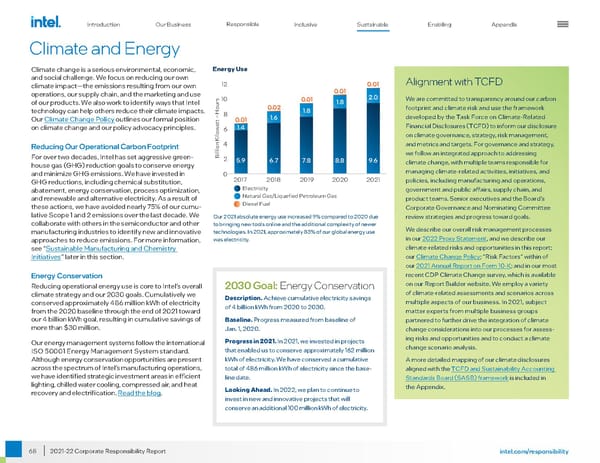68 intel.com/responsibility 2021-22 Corporate Responsibility Report Climate and Energy Climate change is a serious environmental, economic, and social challenge. We focus on reducing our own climate impact—the emissions resulting from our own operations, our supply chain, and the marketing and use of our products. We also work to identify ways that Intel technology can help others reduce their climate impacts. Our Climate Change Policy outlines our formal position on climate change and our policy advocacy principles. Reducing Our Operational Carbon Footprint For over two decades, Intel has set aggressive green - house gas (GHG) reduction goals to conserve energy and minimize GHG emissions. We have invested in GHG reductions, including chemical substitution, abatement, energy conservation, process optimization, and renewable and alternative electricity. As a result of these actions, we have avoided nearly 75% of our cumu - lative Scope 1 and 2 emissions over the last decade. We collaborate with others in the semiconductor and other manufacturing industries to identify new and innovative approaches to reduce emissions. For more information, see “ Sustainable Manufacturing and Chemistry Initiatives ” later in this section. Energy Conservation Reducing operational energy use is core to Intel’s overall climate strategy and our 2030 goals. Cumulatively we conserved approximately 486 million kWh of electricity from the 2020 baseline through the end of 2021 toward our 4 billion kWh goal, resulting in cumulative savings of more than $30 million. Our energy management systems follow the international ISO 50001 Energy Management System standard. Although energy conservation opportunities are present across the spectrum of Intel’s manufacturing operations, we have identified strategic investment areas in efficient lighting, chilled water cooling, compressed air, and heat recovery and electrification. Read the blog . Energy Use Our 2021 absolute energy use increased 9% compared to 2020 due to bringing new tools online and the additional complexity of newer technologies. In 2021, approximately 83% of our global energy use was electricity. Electricity Diesel Fuel Natural Gas/Liquefied Petroleum Gas 4 2 6 8 10 12 0 2021 Billion Kilowatt – Hours 2017 2018 2019 2020 1.6 0.02 6.7 1.8 0.01 7.8 1.8 0.01 8.8 2.0 0.01 9.6 5.9 1.4 0.01 2030 Goal: Energy Conservation Description. Achieve cumulative electricity savings of 4 billion kWh from 2020 to 2030. Baseline. Progress measured from baseline of Jan. 1, 2020. Progress in 2021. In 2021, we invested in projects that enabled us to conserve approximately 162 million kWh of electricity. We have conserved a cumulative total of 486 million kWh of electricity since the base - line date. Looking Ahead. In 2022, we plan to continue to invest in new and innovative projects that will conserve an additional 100 million kWh of electricity. Alignment with TCFD We are committed to transparency around our carbon footprint and climate risk and use the framework developed by the Task Force on Climate-Related Financial Disclosures (TCFD) to inform our disclosure on climate governance, strategy, risk management, and metrics and targets. For governance and strategy, we follow an integrated approach to addressing climate change, with multiple teams responsible for managing climate-related activities, initiatives, and policies, including manufacturing and operations, government and public affairs, supply chain, and product teams. Senior executives and the Board’s Corporate Governance and Nominating Committee review strategies and progress toward goals. We describe our overall risk management processes in our 2022 Proxy Statement , and we describe our climate-related risks and opportunities in this report; our Climate Change Policy ; “Risk Factors” within of our 2021 Annual Report on Form 10-K ; and in our most recent CDP Climate Change survey, which is available on our Report Builder website. We employ a variety of climate-related assessments and scenarios across multiple aspects of our business. In 2021, subject matter experts from multiple business groups partnered to further drive the integration of climate change considerations into our processes for assess - ing risks and opportunities and to conduct a climate change scenario analysis. A more detailed mapping of our climate disclosures aligned with the TCFD and Sustainability Accounting Standards Board (SASB) framework is included in the Appendix. Introduction Our Business Responsible Inclusive Sustainable Enabling Appendix
 Intel Corporate Responsibility Report Page 67 Page 69
Intel Corporate Responsibility Report Page 67 Page 69